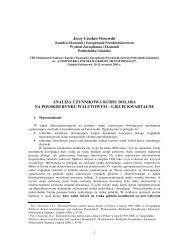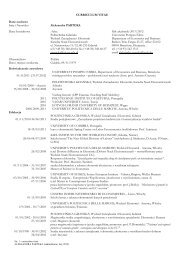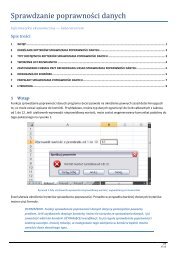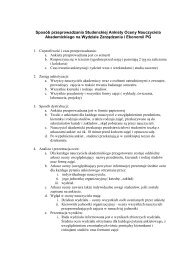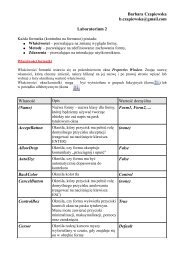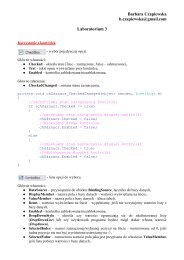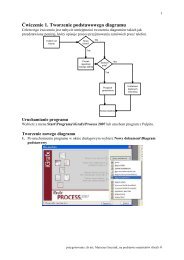Politechnika Gdańska Wydział Zarządzania i Ekonomii Nazwa ...
Politechnika Gdańska Wydział Zarządzania i Ekonomii Nazwa ...
Politechnika Gdańska Wydział Zarządzania i Ekonomii Nazwa ...
Create successful ePaper yourself
Turn your PDF publications into a flip-book with our unique Google optimized e-Paper software.
<strong>Politechnika</strong> <strong>Gdańska</strong><br />
<strong>Wydział</strong> <strong>Zarządzania</strong> i <strong>Ekonomii</strong><br />
<strong>Nazwa</strong> przedmiotu Modeling of Business Processes with Vensim<br />
Software<br />
kierunek Zarządzanie<br />
specjalność Zarządzanie wiedzą i informacją<br />
rodzaj studiów Jednolite studia magisterskie, studia II stopnia<br />
semestr (studia magisterskie) VIII, (studia IV sem.) II, (studia V<br />
sem.) III, (studia VI sem.) IV<br />
liczba godzin W C L 30 s<br />
Liczba punktów ECTS 2<br />
Katedra odpowiedzialna <strong>Zarządzania</strong> Wiedzą i Informacją<br />
Główny prowadzący<br />
telefon kontaktowy<br />
e-mail<br />
Pozostali prowadzący<br />
telefon kontaktowy<br />
e-mail<br />
Wymagane przedmioty<br />
poprzedzające<br />
dr inŜ. Małgorzata Zięba<br />
16-17<br />
mz@zie.pg.gda.pl<br />
-<br />
-<br />
Cele przedmiotu Celem przedmiotu jest zapoznanie studentów z<br />
zasadami myślenia systemowego w oparciu o program<br />
Vensim. Podczas zajęć studenci uczą się zasad<br />
tworzenia modeli w oparciu o opis sytuacji<br />
problemowej.<br />
Forma prowadzenia zajęć Prezentacje multimedialne, rozwiązywanie zadań na<br />
komputerach, udział w dyskusji, analiza przypadków<br />
Forma zaliczenia Zadanie do wykonania na komputerze w programie<br />
Vensim
Treść programu 1) Introduction to systems thinking – simulation<br />
game. Results of the game + discussion (4h)<br />
2) Systems thinking as an illustration of<br />
interactions in business, social sciences and ecology.<br />
(2h)<br />
3) Feedbacks in systems. Examples. (2h)<br />
4) Reinforcing and balancing loops. Determining<br />
the polarity of a loop. (2h)<br />
5) Casual loop diagrams. The analysis of case<br />
studies. (2h)<br />
6) Elements of a model. Stocks, flows and<br />
variables. (2h)<br />
7) Building models based on casual loop diagrams.<br />
Examples. (4h)<br />
8) Introduction to the basic functions of Vensim.<br />
Simulation of a given model and effects visualization.<br />
(2h)<br />
9) Introduction to the advanced functions of<br />
Vensim. (2h)<br />
10) Building models on the basis of a problem<br />
description. (2h)<br />
11) Testing the prepared model and carrying out<br />
simulations. Observation of the results after changing<br />
the parameters. Conclusions. (2h)<br />
12) Delays and oscillations in system. (2h)<br />
13) Leverage points. (2h)<br />
Efekty kształcenia Po kursie studenci są w stanie samodzielnie stworzyć<br />
model w programie Vensim, przeprowadzić jego<br />
symulację oraz przeanalizować wyniki tej symulacji.<br />
Literatura John Sterman, Business Dynamics, Irwin/McGraw-Hill,<br />
2000<br />
Kim Warren, Competitive Strategy Dynamics, Wiley,<br />
2002
Podpis kierownika katedry<br />
Podpis dziekana ds.<br />
kształcenia<br />
Barry Richmond, The “Thinking” in Systems Thinking,<br />
Pegasus Communication, 2000<br />
Peter Senge, The Fifth Discipline: Art and Practice of<br />
the Learning Organization, Random House Business<br />
Books, 1993<br />
Peter Senge, The Fifth Discipline Fieldbook: Strategies<br />
for Building a Learning Organization, Nicholas Brealey<br />
Publishing Ltd, 1994




